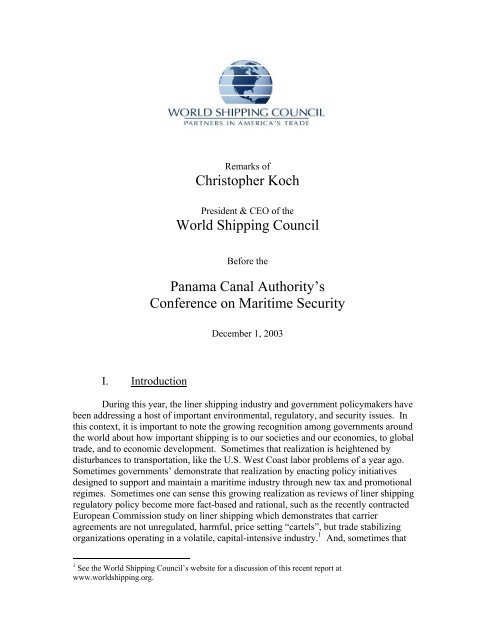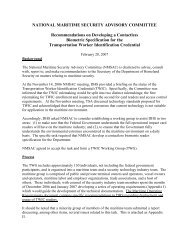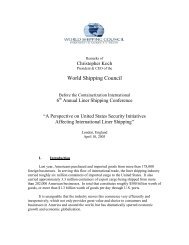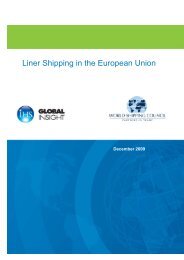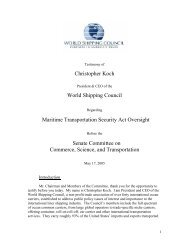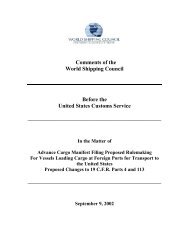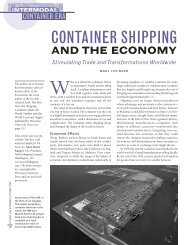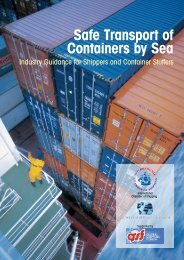Read the speech. - World Shipping Council
Read the speech. - World Shipping Council
Read the speech. - World Shipping Council
Create successful ePaper yourself
Turn your PDF publications into a flip-book with our unique Google optimized e-Paper software.
Remarks of<br />
Christopher Koch<br />
President & CEO of <strong>the</strong><br />
<strong>World</strong> <strong>Shipping</strong> <strong>Council</strong><br />
Before <strong>the</strong><br />
Panama Canal Authority’s<br />
Conference on Maritime Security<br />
December 1, 2003<br />
I. Introduction<br />
During this year, <strong>the</strong> liner shipping industry and government policymakers have<br />
been addressing a host of important environmental, regulatory, and security issues. In<br />
this context, it is important to note <strong>the</strong> growing recognition among governments around<br />
<strong>the</strong> world about how important shipping is to our societies and our economies, to global<br />
trade, and to economic development. Sometimes that realization is heightened by<br />
disturbances to transportation, like <strong>the</strong> U.S. West Coast labor problems of a year ago.<br />
Sometimes governments’ demonstrate that realization by enacting policy initiatives<br />
designed to support and maintain a maritime industry through new tax and promotional<br />
regimes. Sometimes one can sense this growing realization as reviews of liner shipping<br />
regulatory policy become more fact-based and rational, such as <strong>the</strong> recently contracted<br />
European Commission study on liner shipping which demonstrates that carrier<br />
agreements are not unregulated, harmful, price setting “cartels”, but trade stabilizing<br />
organizations operating in a volatile, capital-intensive industry. 1 And, sometimes that<br />
1 See <strong>the</strong> <strong>World</strong> <strong>Shipping</strong> <strong>Council</strong>’s website for a discussion of this recent report at<br />
www.worldshipping.org.
2<br />
recognition is through <strong>the</strong> cooperative partnership that <strong>the</strong> industry continuously works to<br />
build with government to enhance <strong>the</strong> security of maritime commerce from <strong>the</strong> threat of<br />
terrorism.<br />
Today, at <strong>the</strong> kind invitation of <strong>the</strong> Panama Canal Authority and its<br />
Administrator, Senor Alberto Aleman Zubieta, I would like to briefly discuss <strong>the</strong> issue of<br />
how much progress has been made on enhancing <strong>the</strong> security of maritime commerce and<br />
what some of <strong>the</strong> continuing challenges will be. While my remarks will discuss <strong>the</strong><br />
various security measures being implemented by <strong>the</strong> United States government, it is<br />
essential to recognize that enhanced security of this international business requires<br />
international cooperation, and international consistency when possible. Nowhere is <strong>the</strong><br />
need for effective cooperation more apparent than between Panama and <strong>the</strong> U.S., as<br />
roughly 60% of <strong>the</strong> 13,000 vessels transiting <strong>the</strong> canal each year call at U.S. ports.<br />
We face a complex and multi-faceted challenge. But, if nothing else, <strong>the</strong> past two<br />
years’ post-September 11 activities demonstrate that industry and government need to<br />
work closely toge<strong>the</strong>r. There are no good alternatives to open, constructive dialogue and<br />
<strong>the</strong> joint development of effective responses to shared challenges.<br />
To date <strong>the</strong>re has been noteworthy progress, including <strong>the</strong> development of <strong>the</strong><br />
International Ship and Port Facility Security Code (ISPS Code), <strong>the</strong> 24-hour advance<br />
cargo manifest filing requirements, <strong>the</strong> Container Security Initiative agreements, and <strong>the</strong><br />
Customs’ Trade Partnership Against Terrorism (C-TPAT) program. But even <strong>the</strong>se<br />
programs are only beginning efforts that will continue to evolve, not completed projects.<br />
Panama owns and operates arguably <strong>the</strong> most valuable maritime transportation<br />
asset in <strong>the</strong> world – <strong>the</strong> Panama Canal, and its flag registry is <strong>the</strong> largest in <strong>the</strong> world. It<br />
is taking a leadership role in <strong>the</strong> ISPS Code’s implementation. It is <strong>the</strong>refore very<br />
appropriate that we are here in Panama at this conference to take stock of where we are<br />
and to plan for what more will need to be done. It is also appropriate as we ga<strong>the</strong>r at <strong>the</strong><br />
center of <strong>the</strong> Western Hemisphere to examine how <strong>the</strong>se evolving security rules will<br />
affect trade and commerce with Latin America.<br />
In my remarks this morning, I would like to address several different components<br />
of <strong>the</strong> overall maritime security objective, namely enhanced ship security, facility<br />
security, personnel security, and cargo security.<br />
II.<br />
Ships<br />
We are seven months away to <strong>the</strong> day from <strong>the</strong> effective date of <strong>the</strong> International<br />
Ship and Port Facility Security (ISPS) Code and amendments to <strong>the</strong> International<br />
Convention for <strong>the</strong> Safety of Life at Sea (SOLAS), requiring vessel operators to develop<br />
and implement compliant vessel security plans. Compliance will require a significant<br />
effort, and this conference will spend considerable time addressing <strong>the</strong> requirements of<br />
<strong>the</strong> new code, so I will not try to address all of its components. But it is important to
3<br />
recognize first, that <strong>the</strong> Code applies to approximately 50,000 vessels and thousands of<br />
port facilities globally, and second, that <strong>the</strong> Code is more than a set of procedural<br />
requirements and paper practices. It requires vessel operators not only to develop and<br />
implement <strong>the</strong> required measures, but also to have adequate resources available and<br />
trained to do <strong>the</strong> job.<br />
Vessels that are not compliant by <strong>the</strong> July 1 effective date will, at best, face<br />
serious delays at <strong>the</strong> world’s ports, and <strong>the</strong> U.S. Coast Guard has stated its intention to<br />
deny vessels without certificates entry to U.S. ports.<br />
While all vessel registries, flag states and port states should be preparing<br />
diligently for this July deadline, I would like to address several issues that have arisen<br />
regarding <strong>the</strong> approach that <strong>the</strong> U.S. Coast Guard will be using for vessels calling at U.S.<br />
ports.<br />
The first issue is <strong>the</strong> approval of vessel security plans. The Maritime<br />
Transportation Security Act (MTSA), passed by <strong>the</strong> U.S. Congress and requiring all<br />
vessels calling at U.S. ports to have vessel security plans, is being effectively<br />
implemented by <strong>the</strong> U.S. Coast Guard in a way that is entirely consistent with <strong>the</strong> new<br />
international rules and obligations successfully negotiated at <strong>the</strong> IMO. The Coast Guard<br />
deserves considerable credit for simultaneously and successfully partnering with<br />
domestic and international industry stakeholders, <strong>the</strong> IMO and o<strong>the</strong>r governments, o<strong>the</strong>r<br />
federal agencies and <strong>the</strong> U.S. Congress to accomplish this. The Coast Guard’s approach<br />
to <strong>the</strong> implementation of <strong>the</strong> ISPS Code and SOLAS amendments, not only faithfully<br />
implements this new regime that <strong>the</strong> Coast Guard played a key role in creating, but it<br />
enhances maritime security through <strong>the</strong> use of a consistent, uniform international<br />
approach for our industry, which operates within <strong>the</strong> jurisdictions of all <strong>the</strong> maritime<br />
trading nations of <strong>the</strong> world. The Coast Guard regulations also clearly preempt<br />
individual U.S. states from establishing <strong>the</strong>ir own vessel security regulations, thus<br />
ensuring that <strong>the</strong> United States speaks with a single voice on <strong>the</strong>se issues.<br />
We believe that <strong>the</strong> Coast Guard’s efforts in this regard can serve as a model for<br />
future American regulatory endeavors because its approach sought and achieves<br />
consistency and predictability amongst and between domestic and international<br />
requirements.<br />
Flag states have <strong>the</strong> responsibility to ensure that vessels under <strong>the</strong>ir registry are<br />
compliant with <strong>the</strong> new requirements. The Coast Guard has clearly, consistently and<br />
repeatedly stated that <strong>the</strong> U.S. regulations nei<strong>the</strong>r invite nor require foreign flag vessels to<br />
submit <strong>the</strong>ir vessel security plans to <strong>the</strong> Coast Guard for approval. Advice to <strong>the</strong> contrary<br />
should not be followed. The Coast Guard is <strong>the</strong> agency that administers <strong>the</strong>se laws in <strong>the</strong><br />
U.S; it has clearly stated its position logically and forcefully in <strong>the</strong> regulations; it has<br />
clearly explained and defended <strong>the</strong> legal judgment behind its position; and, it has clearly<br />
and repeatedly stated that it will not accept foreign-flag vessel plans.
4<br />
Although <strong>the</strong> House of Representatives has passed a bill that, if enacted into law<br />
would countermand this approach and require foreign flag vessels to submit <strong>the</strong>ir vessel<br />
security plans to <strong>the</strong> Coast Guard for approval, <strong>the</strong>re is no comparable provision in <strong>the</strong><br />
Senate version of <strong>the</strong> legislation, and such legislation is opposed by <strong>the</strong> Coast Guard and<br />
<strong>the</strong> Administration. And for good reason. Such an approach would be inconsistent with<br />
<strong>the</strong> international approach just recently and successfully concluded with <strong>the</strong> U.S.<br />
government’s support at <strong>the</strong> IMO. It would establish <strong>the</strong> unfortunate precedent that every<br />
nation’s vessel security plans would be subject to review and approval by every port state<br />
government where <strong>the</strong> vessel calls. Moreover, it would overwhelm <strong>the</strong> U.S. Coast Guard<br />
with plans that o<strong>the</strong>r governments are already responsible for approving under <strong>the</strong> ISPS<br />
Code. And, <strong>the</strong> Coast Guard has very clearly stated that it will use its port state<br />
enforcement authority to ensure that IMO compliant vessel security plans are in place.<br />
Second, flag states and vessel operators cannot avoid <strong>the</strong>ir responsibilities under<br />
<strong>the</strong> Code, and <strong>the</strong> Coast Guard has made it abundantly clear that it will use its port state<br />
authority to inspect incoming vessels to ensure that foreign flag vessels seeking entry to<br />
<strong>the</strong> United States have approved plans by July 1, 2004 and have implemented adequate<br />
security standards in accordance with <strong>the</strong> ISPS Code and SOLAS amendments. The<br />
Coast Guard’s port state control measures will also include tracking <strong>the</strong> performance of<br />
all owners, operators, flag state administrations, recognized security organizations<br />
(RSOs), charterers and port facilities. The Coast Guard intends to consider a vessel or<br />
port facility’s history of compliance or lack <strong>the</strong>reof as important factors in <strong>the</strong> port state<br />
control equation. Non-compliance with <strong>the</strong> IMO requirements will subject a vessel to an<br />
array of control and compliance measures, from delay for a port state control boarding to<br />
denial of entry into port.<br />
The collaborative development and implementation of <strong>the</strong>se new vessel security<br />
rules by <strong>the</strong> appropriate combination of flag state and port state enforcement are not only<br />
an effective way to enhance maritime security on a global basis, but also to support three<br />
o<strong>the</strong>r important objectives. First, it demonstrates <strong>the</strong> U.S. government’s commitment to<br />
and preference for developing international solutions to <strong>the</strong>se challenges. Second, each<br />
successful international action builds effective momentum for <strong>the</strong> IMO to address o<strong>the</strong>r<br />
maritime challenges more effectively, such as vessel engine air emissions through Annex<br />
VI as it is ratified and becomes effective, such as <strong>the</strong> creation of a new IMO convention<br />
in February of next year to address ships’ ballast water treatment and to prevent <strong>the</strong><br />
unintentional transport of aquatic invasive species, and such as <strong>the</strong> IMO’s possible<br />
development of a long-range vessel tracking system and regime. And third, this new<br />
regime illustrates how <strong>the</strong> international maritime community and governments can come<br />
toge<strong>the</strong>r to establish and implement a uniform and internationally accepted enhancement<br />
of security.<br />
III. Port Facilities<br />
Each contracting government to SOLAS and <strong>the</strong> ISPS Code has <strong>the</strong> right and<br />
obligation to ensure that its port facilities are in compliance with <strong>the</strong> international
5<br />
commitments laid down in those mandatory instruments. Contracting governments are<br />
required to make sure that security assessments are undertaken for <strong>the</strong>ir port facilities,<br />
and that security plans are developed that address identified vulnerabilities and meet <strong>the</strong><br />
requirements of <strong>the</strong> Code.<br />
One set of issues that will require better answers than are available today is –<br />
what are <strong>the</strong> consequences for a vessel with a compliant security plan when it arrives at a<br />
compliant port facility, if it has previously called at a port facility that is not in<br />
compliance during its voyage This is not a <strong>the</strong>oretical question. It is likely that not all<br />
port facilities around <strong>the</strong> world will be compliant by July 1. Vessel operators need to<br />
know in advance whe<strong>the</strong>r and to what extent delays and added operating procedures and<br />
costs can be expected, so that <strong>the</strong>y can plan accordingly. This is especially important for<br />
vessels that operate on fixed schedules, such as liner and cruise ships.<br />
Ano<strong>the</strong>r issue that has attracted attention internationally is <strong>the</strong> provision in <strong>the</strong><br />
MTSA that requires <strong>the</strong> Secretary of Homeland Security to undertake foreign port<br />
assessments. This particular MTSA provision has yet to be implemented, but <strong>the</strong> Coast<br />
Guard’s MTSA regulations state that <strong>the</strong> Coast Guard will be responsible for this<br />
function.<br />
The U.S. Coast Guard has won <strong>the</strong> respect of <strong>the</strong> international community<br />
because of <strong>the</strong> integrity, sensitivity and professionalism that continues to characterize <strong>the</strong><br />
service, and how it executes <strong>the</strong> obligations and rights as a port state to verify calling<br />
foreign vessels’ compliance with international and domestic requirements. Foreign port<br />
assessments will require <strong>the</strong> same skills and professionalism.<br />
They will also require diplomatic finesse and tact. One administration’s request<br />
to be allowed to evaluate ano<strong>the</strong>r administration’s port security assessments and plans<br />
could be perceived as an expression of a lack of trust in <strong>the</strong> integrity and commitment of<br />
<strong>the</strong> host nation to abide by its international commitments -- unless <strong>the</strong> requesting<br />
administration makes such requests appropriately, conducts <strong>the</strong> evaluation with <strong>the</strong> full<br />
cooperation and involvement of <strong>the</strong> host nation, and in accordance with clear, accepted<br />
and verifiable criteria, and, shares <strong>the</strong> results and conclusions of <strong>the</strong> evaluation with <strong>the</strong><br />
host nation.<br />
Requests to evaluate foreign port facilities should also recognize <strong>the</strong> principle of<br />
reciprocity, i.e. a government that requests <strong>the</strong> ability to evaluate ano<strong>the</strong>r nation’s port<br />
facilities should do so in a way that it itself would find acceptable, non-intrusive and nondegrading<br />
if <strong>the</strong> host nation were to reciprocate by wanting to evaluate <strong>the</strong> requesting<br />
nation’s port facilities.<br />
We are confident that <strong>the</strong> Coast Guard would evaluate o<strong>the</strong>r nations’ port<br />
facilities in such a considerate and transparent way. Mindful, however, of <strong>the</strong> particular<br />
interest devoted to this issue during <strong>the</strong> IMO negotiations and afterwards, we have<br />
encouraged <strong>the</strong> Coast Guard to develop a prudent and transparent framework for its<br />
foreign port assessments that can be shared, beforehand, with o<strong>the</strong>r nations’ maritime
6<br />
administrations, and which confirms <strong>the</strong> Coast Guard’s intention to base such<br />
assessments on <strong>the</strong> criteria, standards and principles laid down in <strong>the</strong> relevant<br />
internationally agreed instruments, i.e. SOLAS and <strong>the</strong> ISPS Code.<br />
IV.<br />
People<br />
Within <strong>the</strong> United States, <strong>the</strong> Department of Homeland Security is developing a<br />
Transport Worker Identification Card for all domestic transport workers in each<br />
transportation mode, which will require government background checks and biometric<br />
identifiers. It is unclear when this system will become operational, but several pilot<br />
projects are underway, and it is possible that a system could become operational before<br />
<strong>the</strong> end of 2004.<br />
Regarding seafarers, <strong>the</strong> United States has for many years had its own rules<br />
governing <strong>the</strong>ir entry into <strong>the</strong> country. After September 11 and in light of a number of<br />
reported cases of seafarers jumping ship and not returning to <strong>the</strong>ir vessels, and of <strong>the</strong><br />
need to ensure that vessels do not become a pathway for terrorists to enter <strong>the</strong> country,<br />
<strong>the</strong> U.S. government has undertaken a number of changes to <strong>the</strong> rules affecting seafarers.<br />
First, while no official decision has been announced, <strong>the</strong> U.S. government,<br />
effective last August, terminated its use of crew list visas, and now requires each seafarer<br />
to obtain an individual visa from a U.S. embassy or consulate. Because of both <strong>the</strong><br />
general requirement that visa applicants be interviewed and backlogs in processing visas<br />
at U.S. embassies and consulates – particularly in seafarer producing countries, it is<br />
probable that seafarers may find that <strong>the</strong>y cannot get a visa in time to sail. This can result<br />
in vessels arriving in U.S. ports with crew members aboard who do not have valid<br />
individual seafarer visas. In such cases, <strong>the</strong>y will be unable to obtain shore privileges,<br />
and <strong>the</strong> vessel operator may incur additional costs of guards at <strong>the</strong> gangway. It may also<br />
result in difficulties for ship operators in scheduling signing off/signing on seafarers in<br />
U.S. ports.<br />
Second, today information on all crew members is transmitted electronically to<br />
<strong>the</strong> Coast Guard 96 hours in advance of a vessel’s arrival in a U.S. port, and upon arrival<br />
to Customs and Border Protection (CBP). Effective early next year, crew member<br />
information will also be required to be submitted electronically 96 hours in advance of<br />
arrival to CBP via its Advance Passenger Information System (APIS). The crew member<br />
information is used to screen <strong>the</strong>se individuals through government information systems.<br />
Both agencies and <strong>the</strong> industry agree that <strong>the</strong>re should be a “single window” for <strong>the</strong><br />
advance electronic filing of such information that can be shared among government<br />
agencies. Yet both agencies continue to develop separate procedures and information<br />
systems, and <strong>the</strong> “single window” remains elusive. We have been working with <strong>the</strong><br />
government and urging it to establish a single mechanism to file this information, and we<br />
will continue to advocate that this be done in 2004.
7<br />
Third, in January of 2004 <strong>the</strong> U.S. will begin implementing “<strong>the</strong> United States<br />
Visitor and Immigrant Status Indicator Technology” -- commonly known as <strong>the</strong> US-<br />
VISIT program. The statutory deadlines are tight, and <strong>the</strong> information systems issues<br />
involved are very challenging, so it has come as no surprise that DHS is falling behind in<br />
implementing <strong>the</strong> program. The Department has <strong>the</strong>refore chosen to roll <strong>the</strong> program out<br />
in increments. This means that US-VISIT’s application to foreign seafarers seeking<br />
shore privileges, signing off, signing on, and transiting from one vessel to ano<strong>the</strong>r in <strong>the</strong><br />
United States will be fairly limited at first. Foreign seafarers will, however, have to<br />
comply with <strong>the</strong> program from January 5, 2004, when flying into and departing <strong>the</strong><br />
United States by plane.<br />
Fourth and finally, <strong>the</strong>re is still a question about what role, if any, <strong>the</strong> new<br />
proposed International Labor Organization (ILO) seafarer credential may have in <strong>the</strong><br />
United States. Although <strong>the</strong> U.S. government participated in <strong>the</strong> negotiations at <strong>the</strong> ILO<br />
that developed <strong>the</strong> new proposed seafarer credential, it was unable to clearly define what<br />
its objectives were in <strong>the</strong>se negotiations, and cannot today articulate what purpose would<br />
be served by <strong>the</strong> new document, nor whe<strong>the</strong>r <strong>the</strong> ILO agreement will be sent to <strong>the</strong><br />
Senate for ratification.<br />
Seafarers still will need a passport and an individual visa with biometric<br />
identifiers that are not compatible with <strong>the</strong> proposed new ILO document’s, and <strong>the</strong> VISIT<br />
program is <strong>the</strong> system that -- also using biometric identifiers that are incompatible with<br />
<strong>the</strong> proposed ILO document -- will record entry and exit from <strong>the</strong> country. As a result, it<br />
appears that <strong>the</strong> ILO document would serve no role as a travel document in <strong>the</strong> U.S..<br />
Some non-DHS government officials have alluded to <strong>the</strong> possibility that <strong>the</strong> card<br />
might be used to expedite seafarers individual visas 2 , but <strong>the</strong>re has been no action on this<br />
and no decision from DHS. The industry and o<strong>the</strong>r nations are obviously interested if<br />
<strong>the</strong>re is a reason to implement this new credentialing agreement, and none has yet been<br />
articulated for <strong>the</strong> U.S. trades. We hope that DHS will address this issue in <strong>the</strong> near<br />
future.<br />
As noted above, <strong>the</strong> industry recognizes <strong>the</strong> need for effective security measures<br />
and supports <strong>the</strong> government’s efforts to achieve that goal. But we do hope that, in 2004,<br />
<strong>the</strong> uncoordinated and duplicative processes governing seafarers arriving in <strong>the</strong> United<br />
States can be remedied, and that policy makers will recognize that <strong>the</strong> totality of all <strong>the</strong>se<br />
various measures can cause significant difficulties and constraints for honest seafarers,<br />
who are in many respects a first line of defense in <strong>the</strong> maritime security effort.<br />
V. Cargo Security<br />
For ocean common carriers and many governments and shippers, cargo and<br />
container security has been a priority issue. In <strong>the</strong> United States liner trades, we have<br />
2 The <strong>World</strong> <strong>Shipping</strong> <strong>Council</strong> has submitted to <strong>the</strong> government detailed comments with some possible<br />
suggestions in this regard. See <strong>the</strong> <strong>Council</strong>’s website at http://www.worldshipping.org/iss_5.html for <strong>the</strong><br />
most recent submission to <strong>the</strong> U.S. Department of State (September 4, 2003).
8<br />
seen <strong>the</strong> implementation of <strong>the</strong> requirement to submit advance cargo manifest<br />
information to <strong>the</strong> government for security screening 24 hours before vessel loading in a<br />
foreign port, <strong>the</strong> development of Customs’ Trade Partnership Against Terrorism (C-<br />
TPAT) initiatives, and <strong>the</strong> negotiation and implementation of Container Security<br />
Initiative (CSI) agreements between <strong>the</strong> U.S. government and its trading partners. Each<br />
of <strong>the</strong>se is an important component of <strong>the</strong> effort to enhance security.<br />
We have also seen <strong>the</strong> U.S and o<strong>the</strong>r governments try to get <strong>the</strong> <strong>World</strong> Customs<br />
Organization (WCO) to develop effective, mandatory uniform international container<br />
security standards, like <strong>the</strong> U.S. Coast Guard and <strong>the</strong> IMO did for ships and port<br />
facilities. Unfortunately, no Latin American Customs administrations have participated in<br />
<strong>the</strong> proceedings of <strong>the</strong> WCO’s Task Force on Security and Trade Facilitation. The<br />
<strong>Council</strong> and U.S. Customs officials have worked diligently in support of this objective;<br />
however, it appears that <strong>the</strong> WCO is ei<strong>the</strong>r unwilling or incapable, or both, of addressing<br />
container security in a meaningful and comprehensive way. It may yet produce<br />
guidelines or “best practices” for <strong>the</strong>se issues, but this would seem to fall far short of an<br />
international instrument comparable to <strong>the</strong> ISPS Code. There are too many governments’<br />
customs officials at <strong>the</strong> WCO that ei<strong>the</strong>r do not see cargo security as within <strong>the</strong>ir<br />
responsibility, or do not see it as an issue requiring meaningful WCO action.<br />
What this means is that, without an effective international body addressing <strong>the</strong>se<br />
issues, fur<strong>the</strong>r U.S. cargo security measures will be undertaken ei<strong>the</strong>r on a unilateral basis<br />
or pursuant to bilateral CSI agreements. In this regard, we welcome <strong>the</strong> announcement<br />
last month that <strong>the</strong> European Commission and U.S. government have agreed to intensify<br />
and broaden <strong>the</strong>ir Customs co-operation to improve <strong>the</strong> security of sea-containers and<br />
o<strong>the</strong>r shipments that are imported into, transshipped through or transiting <strong>the</strong> European<br />
Community and <strong>the</strong> United States. But it is also important that in <strong>the</strong> effort to address <strong>the</strong><br />
largest volume trade lanes, that Latin America trades not be overlooked or disadvantaged.<br />
Accordingly, we encourage Latin American governments to, not only make sure that <strong>the</strong>ir<br />
vessels and port facilities are ISPS Code compliant by July 1, but that <strong>the</strong>y carefully<br />
consider <strong>the</strong> steps involved and potential value in entering into CSI agreements.<br />
As <strong>the</strong>re is considerable regulatory activity in <strong>the</strong> area of containerized cargo<br />
security, let me briefly touch on developments in each of <strong>the</strong> following areas: secure<br />
container loading, cargo documentation and screening, and in-transit security.<br />
A. Secure Container Loading<br />
Secure container loading is <strong>the</strong> starting point, and arguably <strong>the</strong> single, most<br />
important point, in <strong>the</strong> container security process. It is also <strong>the</strong> most difficult to address<br />
because it involves millions of containers being loaded at tens of thousands of different<br />
locations in every country in <strong>the</strong> world. An ocean carrier is like <strong>the</strong> postman; it receives a<br />
sealed container for transportation, and has no first hand knowledge of what has been<br />
loaded inside. Unless <strong>the</strong> carrier is aware of information that arouses its suspicion about<br />
a particular container, it has little choice but to trust what shipping documents state is in<br />
<strong>the</strong> container and that <strong>the</strong> loading process was secure.
9<br />
The Customs Trade Partnership Against Terrorism (C-TPAT) program is one way<br />
to try to effect improvements in this regard, but this is a substantial challenge. We expect<br />
that <strong>the</strong> Bureau of Customs and Border Protection (CBP or Customs) will continue to try<br />
to expand <strong>the</strong> voluntary C-TPAT program into an initiative that includes manufactures<br />
and suppliers outside <strong>the</strong> United States. It is also noticeable that <strong>the</strong> focus of C-TPAT<br />
has been on <strong>the</strong> largest volume trades and on <strong>the</strong> inclusion of European and Asian<br />
manufacturers. This could have implications for <strong>the</strong> ability of Latin American exports to<br />
<strong>the</strong> United States to qualify for <strong>the</strong> “low risk” status and any associated benefits under <strong>the</strong><br />
C-TPAT program. We expect o<strong>the</strong>r governments and shippers <strong>the</strong>mselves will continue<br />
to take measures to tighten supply chain security. But it is a tall order, and will also<br />
require continued developments in <strong>the</strong> areas of cargo documentation and screening.<br />
B. Cargo Documentation<br />
Cargo documentation and screening has been one of <strong>the</strong> most active areas of<br />
change, and we expect 2004 will see this continue. We began 2003 with <strong>the</strong><br />
implementation in U.S. trades of <strong>the</strong> requirement to file cargo manifests with Customs<br />
24-hours before vessel loading. This change, while substantial, has been implemented<br />
relatively smoothly and has involved a very open and cooperative relationship between<br />
<strong>the</strong> industry and government. We understand its importance and its relevance to <strong>the</strong><br />
security strategy being deployed. But some fur<strong>the</strong>r changes are apparent, and some --<br />
that are not presently apparent -- are inevitable. I will try to briefly list some of <strong>the</strong>se that<br />
will affect U.S. international commerce:<br />
1. Trade Act Regulations: U.S. Import Cargo<br />
At <strong>the</strong> end of this week, CBP will publish new regulations implementing<br />
requirements of <strong>the</strong> Trade Act of 2003 and addressing cargo documentation requirements<br />
for all transport modes. For ocean shipping, one of <strong>the</strong> more significant issues will be<br />
how <strong>the</strong> final Customs regulations differ from <strong>the</strong> proposed regulations’ efforts to require<br />
<strong>the</strong> “shipper” box on a transportation bill of lading to state <strong>the</strong> name of an importer’s<br />
actual supplier. The issue is complex. Time does not permit a full discussion of that<br />
issue here today, but <strong>the</strong> <strong>Council</strong>’s detailed August 22 comments to CBP on this topic can<br />
be found on our website.<br />
2. Trade Act Regulations: U.S. Export Cargo<br />
We understand that <strong>the</strong> new regulations will require U.S. exporters to file an<br />
electronic Shipper’s Export Declaration (SED) for export vessel cargo directly to <strong>the</strong><br />
government via <strong>the</strong> Automated Export System (AES) no later than 24 hours prior to<br />
vessel departure. The carrier may not load export cargo without first receiving from <strong>the</strong><br />
U.S. exporter ei<strong>the</strong>r <strong>the</strong> electronic SED filing confirmation number or an appropriate<br />
exemption statement. There are expected to be several exemptions from <strong>the</strong> advance<br />
SED export cargo filing requirement depending on <strong>the</strong> value of <strong>the</strong> shipment, <strong>the</strong> size and<br />
nature of <strong>the</strong> U.S. exporter, and possibly also <strong>the</strong> types of cargo.
10<br />
The Trade Act export information requirements can only take effect once ano<strong>the</strong>r<br />
rulemaking from ano<strong>the</strong>r government agency (U.S. Census), requiring <strong>the</strong> electronic<br />
submission of SEDs, has been proposed and taken effect. Therefore, <strong>the</strong>se export cargo<br />
requirements will likely take effect in <strong>the</strong> fall of 2004.<br />
3. Food Import Regulations:<br />
The U.S. Congress recently passed <strong>the</strong> Public Health Security and Bioterrorism<br />
Preparedness and Response Act of 2002 (“Bioterrorism Act”), which requires food<br />
facility registration and prior notification of certain imported food be provided to <strong>the</strong> U.S.<br />
Food and Drug Administration (FDA) before its arrival in <strong>the</strong> United States. While <strong>the</strong>se<br />
regulations become effective on December 12, FDA and CBP recognize that this new<br />
system is untested and replete with potential problems, and <strong>the</strong>refore have indicated <strong>the</strong>ir<br />
intent to not enforce penalties or delay cargo shipments in <strong>the</strong> first several months of <strong>the</strong><br />
rules’ implementation.<br />
Because <strong>the</strong> United States imports approximately $50 billion worth of food<br />
products, and because <strong>the</strong>se rules are so extensive and new, considerable effort and<br />
adaptation by food shippers, brokers and carriers will be needed.<br />
First, <strong>the</strong>se regulations require every facility in <strong>the</strong> world that produces or holds<br />
FDA-regulated food products shipped to <strong>the</strong> United States to register with <strong>the</strong> FDA and<br />
have a U.S. agent. Second, <strong>the</strong>y require every FDA regulated food shipment to file<br />
detailed information about <strong>the</strong> product prior to its arrival in <strong>the</strong> United States, and <strong>the</strong>y<br />
identify carriers as <strong>the</strong> parties through whom <strong>the</strong> government will stop cargo that is not<br />
compliant with <strong>the</strong> new rules.<br />
While some issues remain unclear 3 , some things about <strong>the</strong>se rules appear likely:<br />
• Documentation of FDA regulated food shipments that travel to or through <strong>the</strong><br />
U.S. will become much more complicated, and failure to comply will mean<br />
that, after <strong>the</strong> initial transition phase is over in early 2004, <strong>the</strong> imported food<br />
will not be released from <strong>the</strong> U.S. port of arrival.<br />
• Foreign food shipments to Canada and Mexico will encounter much simpler<br />
documentation requirements if <strong>the</strong>y are unloaded at a Canadian or Mexican<br />
port than if <strong>the</strong>y travel through a U.S. port.<br />
• Foreign food shipments to <strong>the</strong> U.S. are likely to encounter less chance of<br />
documentation problems if <strong>the</strong>y are unloaded at a U.S. port than if <strong>the</strong>y are<br />
brought to <strong>the</strong> U.S. via Canadian or Mexican ports.<br />
3 For more information on <strong>the</strong>se new food import regulations, visit <strong>the</strong> FDA’s website at:<br />
www.fda.gov/oc/bioterrorism/bioact.html
11<br />
FDA has invited ano<strong>the</strong>r round of public comments on <strong>the</strong>se rules to be submitted<br />
by December 24. The <strong>Council</strong> and many o<strong>the</strong>rs will be filing comments.<br />
C. Cargo Screening and Inspection<br />
For U.S containerized shipping, CBP, toge<strong>the</strong>r with a growing number of o<strong>the</strong>r<br />
government’s customs authorities, are screening information about cargo shipments more<br />
closely. The documentation of 100 percent of all imported containerized cargo shipments<br />
is screened by CBP for security purposes before vessel loading. Any shipment that does<br />
not pass <strong>the</strong> applicable risk assessment criteria is <strong>the</strong>n subject to inspection.<br />
Governments and ports are deploying more X-ray, gamma ray, and radiation<br />
detection inspection equipment. Since September 11, CBP has more than doubled <strong>the</strong><br />
number of containers that it physically inspects, and that number is likely to continue to<br />
rise as shipment screening capabilities become more robust, as <strong>the</strong> availability of nonintrusive<br />
container inspection equipment increases, and as initiatives such as C-TPAT<br />
become more prescriptive. The CSI initiative is also developing <strong>the</strong> necessary, reciprocal<br />
government operating arrangements that can allow shipments to be inspected at <strong>the</strong> port<br />
of loading, and not just <strong>the</strong> port of discharge.<br />
I would like to briefly mention two aspects of <strong>the</strong>se container inspection and<br />
screening developments. One involves <strong>the</strong> implications for marine terminals, and <strong>the</strong><br />
o<strong>the</strong>r involves <strong>the</strong> improvement of <strong>the</strong> risk assessment screening.<br />
Marine terminals serving U.S. trades need to consider <strong>the</strong> importance of working<br />
with U.S. and o<strong>the</strong>r government authorities to undertake effective cargo security<br />
planning. For example, a port facility handling transshipment cargo that is ISPS Code<br />
compliant and at a CSI port may be more attractive for shippers and carriers to deal with<br />
than one that is not – because ship schedules and cargo flows are likely to be more<br />
predictable and efficient than if <strong>the</strong> port facility is not compliant or security questions<br />
about cargo cannot be addressed at origin. Similarly, terminal facilities would be better<br />
prepared to keep trade flowing through <strong>the</strong>ir port after a terrorist incident if <strong>the</strong>y are ISPS<br />
Code compliant and in CSI ports. There are indeed challenges involved, such as planning<br />
for how and where <strong>the</strong> increase in container inspections can be accommodated at ports<br />
without unduly disrupting operations, and such as how smaller ports can undertake <strong>the</strong><br />
steps necessary to become CSI ports. But, if a port believes that cargo security<br />
challenges can simply be left to carriers and <strong>the</strong> receiving ports’ government to handle,<br />
one should not be surprised if trade through that port may encounter increasing<br />
difficulties under <strong>the</strong> evolving rules. We note that a number of U.S. port facilities are<br />
going significantly beyond minimum requirements and are, for example, deploying<br />
radiation detection technology that is used on all containers entering and leaving <strong>the</strong><br />
facility.<br />
The second issue in this regard is <strong>the</strong> improvement of shipment risk assessment<br />
screening. As discussed earlier, carriers’ cargo manifests have been <strong>the</strong> best available
12<br />
advance cargo information for <strong>the</strong> government to use for risk assessment pre-screening of<br />
cargo. The <strong>Council</strong> and its Members have strongly supported Customs’ implementation<br />
of <strong>the</strong> 24-hour rule to get this data earlier, and this system has clearly improved trade<br />
documentation practices and <strong>the</strong> information <strong>the</strong> government receives.<br />
As U.S. Secretary of Homeland Security Ridge has stated: “Advance information<br />
is a cornerstone in our efforts to secure our nation’s borders and ensure <strong>the</strong> flow of<br />
trade.” With advance information playing such an important role, <strong>the</strong> quality of that<br />
advance information will certainly receive closer scrutiny. The present information<br />
system for U.S. import ocean carriage has known limitations.<br />
First of all, <strong>the</strong> bill of lading data that is used is only <strong>the</strong> data <strong>the</strong> carrier needs for<br />
its transportation responsibilities, and much of it is not within <strong>the</strong> direct knowledge of <strong>the</strong><br />
carrier, but is second hand information. To improve <strong>the</strong> quality of that data one must<br />
recognize that shippers often will not fully disclose commercial data to <strong>the</strong>ir carrier.<br />
Occasionally, this may not be for legitimate reasons, but it may be for entirely legitimate,<br />
commercial reasons. The data that <strong>the</strong> government needs that is within <strong>the</strong> knowledge of<br />
<strong>the</strong> shipper should be derived from and filed by <strong>the</strong> shipper.<br />
Second, <strong>the</strong>re are data gaps in <strong>the</strong> present system. For example, bills of lading<br />
may, but may not, capture information about <strong>the</strong> origin or prior handling of <strong>the</strong> shipment.<br />
A port-to-port bill of lading will not reveal <strong>the</strong> history of <strong>the</strong> shipment prior to <strong>the</strong><br />
originating port. The carrier may not possess this information, and relying only on its bill<br />
of lading provides an incomplete picture of <strong>the</strong> risk profile of a shipment. These kinds of<br />
issues should cause <strong>the</strong> government to undertake a security “gap analysis” to assess what<br />
data <strong>the</strong> government needs, from whom, when in order to improve its security-screening<br />
capability.<br />
One should not underestimate <strong>the</strong> fact that this is a difficult and complex area, but<br />
<strong>the</strong>re is also an excellent opportunity to address <strong>the</strong>se issues in <strong>the</strong> coming year. CBP is<br />
in <strong>the</strong> process of developing and rolling out in stages its new Automated Commercial<br />
Environment system (ACE). Now is <strong>the</strong> time for that system to be designed to<br />
incorporate new cargo screening security requirements and to determine what new data is<br />
needed, from whom, when -- as <strong>the</strong> program is designed.<br />
D. In-Transit Container Security<br />
While <strong>the</strong> secure initial loading of a container and <strong>the</strong> effective application of<br />
sound risk assessment to shipments are essential to <strong>the</strong> security of international<br />
commerce, it also true that <strong>the</strong> security of a container while it is in transit is very<br />
important. It is <strong>the</strong> third component of <strong>the</strong> cargo security strategy of addressing <strong>the</strong><br />
secure stuffing of <strong>the</strong> container, <strong>the</strong> effective screening and risk assessment of <strong>the</strong><br />
container, and <strong>the</strong> secure transit of <strong>the</strong> container.
13<br />
Recognizing that fact, <strong>the</strong> <strong>World</strong> <strong>Shipping</strong> <strong>Council</strong>’s Security Advisory<br />
Committee, toge<strong>the</strong>r with <strong>the</strong> International Mass Retail Association and <strong>the</strong> National<br />
Industrial Transportation League, developed and submitted to <strong>the</strong> U.S. government and<br />
<strong>the</strong> <strong>World</strong> Customs Organization a White Paper outlining a set of recommendations on<br />
<strong>the</strong> issue. 4 It recommends a set of regulatory requirements applicable to all containerized<br />
shipments, and offers some initial observations on <strong>the</strong> questions of how technology might<br />
be considered in addressing <strong>the</strong> issue of detecting in-transit tampering with shipments.<br />
The issues involved are not simple as <strong>the</strong>y touch on numerous jurisdictions,<br />
numerous commercial parties and <strong>the</strong>ir operating practices, and government information<br />
systems and responsibilities.<br />
When <strong>the</strong> multitude of potential, future technology products are added to <strong>the</strong><br />
consideration of this issue, <strong>the</strong>se issues become even more complicated.<br />
The path forward requires clarity in deciding what <strong>the</strong> security requirements<br />
should be, and <strong>the</strong> essential need to address -- not just what a technology proponent says<br />
its device can do – but a clear and candid assessment of <strong>the</strong> operational and information<br />
system implications, roles and responsibilities of a technology. The debate and analysis<br />
in this regard has been poor at best. Why Because it is difficult.<br />
It is much easier for a technology vendor to say we need a “smart” container and<br />
my device will make it “smarter”, than it is to clearly articulate and establish:<br />
• What is <strong>the</strong> security requirement we are trying to establish and address, and<br />
does <strong>the</strong> government agree<br />
• What are <strong>the</strong> operational implications and demands for <strong>the</strong> device to meet<br />
those requirements when it is deployed in <strong>the</strong> international commercial<br />
environment<br />
• What information is generated by <strong>the</strong> device, who receives it, whose<br />
information system is responsible for it, who has access to it, and who is<br />
responsible for acting on it<br />
• Does it work For example, does it create a significant number of false<br />
positive alerts<br />
• If it is to be operated by <strong>the</strong> private sector ra<strong>the</strong>r than <strong>the</strong> government, where<br />
does <strong>the</strong> technology vendor earn its revenues in <strong>the</strong> process<br />
• And, if it is to be operated by <strong>the</strong> private sector ra<strong>the</strong>r than <strong>the</strong> government, is<br />
<strong>the</strong> requirement capable of being met through a competitive market of<br />
equivalent products<br />
In <strong>the</strong> United States, <strong>the</strong>re is a program in <strong>the</strong> Transportation Security<br />
Administration – Operation Safe Commerce – that may be addressing some aspects of<br />
4 The White Paper, entitled “In-Transit Container Security Enhancement”, dated September 9, 2003, can<br />
be found on <strong>the</strong> <strong>Council</strong>’s website.
14<br />
<strong>the</strong>se issues; however, because <strong>the</strong> industry has little visibility into <strong>the</strong>se efforts, we are<br />
unable to provide an assessment of that program at this point.<br />
There is also an evolving effort led by CBP through <strong>the</strong> C-TPAT program to<br />
develop a C-TPAT “smart and secure container”, which will need to address <strong>the</strong>se issues.<br />
CBP, which plans to begin testing this concept with a limited number of C-TPAT<br />
importers beginning in January of 2004, has expressed <strong>the</strong> objective of linking expedited<br />
processing and cargo release to multiple components of a secure supply chain.<br />
Specifically, this pilot program appears to envision: 1) a foreign vendor or manufacturer<br />
that meets C-TPAT security standards at <strong>the</strong> point of loading (“stuffing”), or a C-TPAT<br />
importer who has assured that its foreign vendors meet C-TPAT security standards at <strong>the</strong><br />
point of stuffing; 2) a C-TPAT “smart and secure container” (meaning one that uses a<br />
high security manual seal, a secure application of <strong>the</strong> seal in a location o<strong>the</strong>r than <strong>the</strong><br />
door handle, and an intrusion sensor); 3) shipment through a foreign port that participates<br />
in <strong>the</strong> CSI program; 4) carriage by a C-TPAT carrier; and 5) delivery to a C-TPAT<br />
importer.<br />
CBP has stated that it will be <strong>the</strong> party reading <strong>the</strong> sensor in this pilot program.<br />
Should this pilot prove <strong>the</strong> sensor to be an effective and workable device, a key question<br />
of interest to every terminal operator, shipper and carrier, if <strong>the</strong> system is to be made<br />
applicable to trade generally, will be whe<strong>the</strong>r CBP plans to continue in <strong>the</strong> role of sensor<br />
reader, or whe<strong>the</strong>r terminal facilities around <strong>the</strong> world will be expected to implement this<br />
for C-TPAT shippers in U.S. commerce. The former approach would substantially<br />
reduce <strong>the</strong> number of issues and obstacles that would have to be considered. While <strong>the</strong>re<br />
are numerous questions about how this initiative will proceed, Customs has worked<br />
closely with <strong>the</strong> industry and o<strong>the</strong>r governments in <strong>the</strong> past, and we expect that <strong>the</strong>y will<br />
work to build on that partnership going forward.<br />
VI.<br />
Conclusion<br />
Each of <strong>the</strong> initiatives discussed above, involving ships, port facilities, people,<br />
cargo security, cargo screening, inspection, and risk assessment capabilities is an<br />
important part of a multi-layered effort to enhance <strong>the</strong> security of international<br />
commerce. It is a complex and multi-faceted security infrastructure that is being built,<br />
but we now live in a world where it must be built, and all sectors of industry and all<br />
trading nations must work toge<strong>the</strong>r to help create it.<br />
We should also recognize that <strong>the</strong> security infrastructure we are trying to build to<br />
prevent terrorists from using or attacking international maritime trade needs to be built to<br />
be robust enough to function as <strong>the</strong> security infrastructure that will be used to keep trade<br />
flowing in response to an incident.<br />
It thus must not only be effective in design, but all <strong>the</strong> players’ roles and<br />
responsibilities should be clear. Ambiguity in <strong>the</strong> face of difficult questions is
15<br />
understandable, but it nei<strong>the</strong>r advances effective security, nor helps government or<br />
industry understand what it needs to do to adapt to meet <strong>the</strong>se evolving needs.<br />
We are making substantial progress in enhancing <strong>the</strong> security or international<br />
trade. The system is certainly more secure now than it was two years ago. It will be even<br />
more secure next year. But, as I stated at <strong>the</strong> beginning of my remarks, <strong>the</strong> past two<br />
years’ post-September 11 activities demonstrate that industry and government must work<br />
closely toge<strong>the</strong>r. There are no good alternatives to open, constructive dialogue and <strong>the</strong><br />
joint development of effective solutions to shared challenges.


